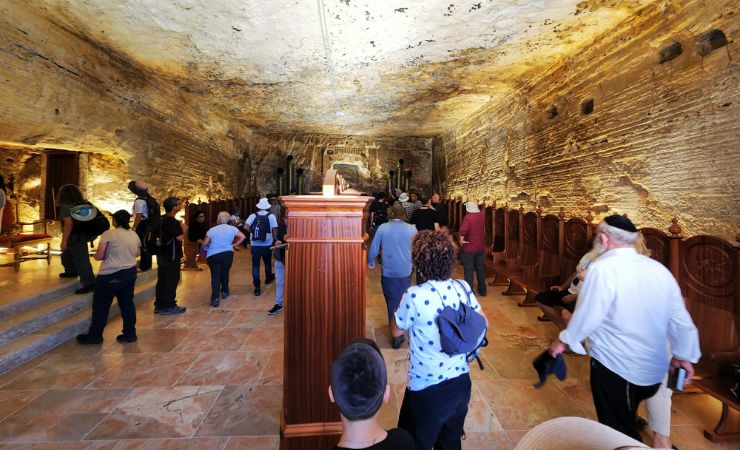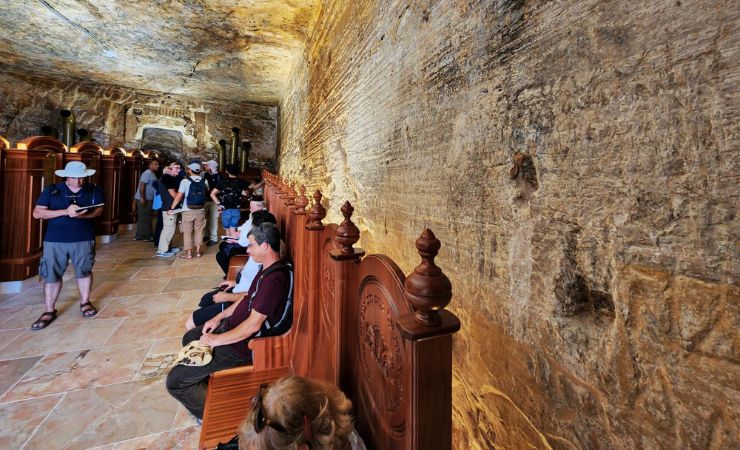Elijah’s Cave: A Biblical Sanctuary in Haifa
Tucked into the rugged slopes of Mount Carmel in Haifa lies Elijah’s Cave. This small, unassuming cave is believed to have sheltered the prophet Elijah during his tumultuous life.

Location
Elijah’s Cave is located on the western side of Mount Carmel, near the city of Haifa, one of Israel’s major coastal cities.
Biblical context
Elijah’s Cave holds a special place in Jewish, Christian, and Muslim traditions. According to biblical accounts, this is believed to be one of the caves where the prophet Elijah sought refuge. In 1 Kings 19, Elijah fled to Mount Carmel after his dramatic confrontation with the prophets of Baal.
After his dramatic showdown with the prophets of Baal on Mount Carmel, Elijah fled to escape the wrath of Queen Jezebel, who had vowed to kill him. Feeling defeated and fearing for his life, Elijah sought a place of refuge where he could rest and reconnect with God.
Though the Bible doesn’t specify the exact cave on Mount Carmel, Jewish tradition holds that the cave currently venerated as Elijah’s Cave is where he may have hidden during this period of distress. This tradition developed over centuries as pilgrims and religious scholars associated this specific location with Elijah’s story, especially given its proximity to the place of the famous confrontation with the prophets of Baal.




The History of Elija's Cave
Throughout history, Elijah’s Cave has served as a sacred spot for followers of Judaism, Christianity, and Islam.
Its association with Elijah dates back thousands of years. Jewish pilgrims have venerated the site, believing that Elijah prayed and sought shelter in this very cave.
- Jewish tradition: Many believe that Elijah’s spirit continues to watch over the people of Israel, making this cave a place where worshippers seek blessings.
- Christian tradition: Elijah’s role as a precursor to Christ in the New Testament has made the cave a pilgrimage site for Christians, especially for those following the story of Jesus’ transfiguration, where Elijah appears alongside Moses.
- Muslim tradition: Elijah is recognized as a prophet in Islam, and thus, the cave is also respected within Islamic culture, where he’s referred to as “Al-Khidr.”
The cave has gone through several renovations and adaptations over the centuries, with the oldest documented references coming from early medieval pilgrims.
What can be Found at the Site
- The Cave Itself: The cave is small and unassuming but steeped in an aura of sanctity. Inside, visitors will see religious symbols and prayers written in Hebrew, Arabic, and Latin. The space is often filled with the soft glow of candles lit by worshippers and pilgrims.
- Torah Scrolls and Prayer Books: For Jewish visitors, Torah scrolls and other religious items are available for prayer within the cave.
- Christian Icons: The cave also features Christian icons and offerings left by believers, reflecting the site’s multicultural and multi-faith significance.
- Visitor Areas: A section of the cave is reserved for quiet contemplation and prayer, while a small outdoor area offers stunning views of the Mediterranean and the Carmel Mountains.
- Elaborate Decorations: Over time, the cave has been adorned with intricate religious mosaics, inscriptions, and other symbols of devotion.
Sources and Additional Information
Nearby Sites
- Stella Maris Monastery: Just a short walk from Elijah’s Cave, this Carmelite monastery offers a spiritual atmosphere and panoramic views of Haifa Bay.
- Baha’i Gardens: A breathtaking terraced garden, descending from Mount Carmel towards the sea, that serves as the world center of the Baha’i faith.
- German Colony: A beautifully preserved neighborhood at the foot of Mount Carmel, full of charming cafes, restaurants, and historical buildings.



